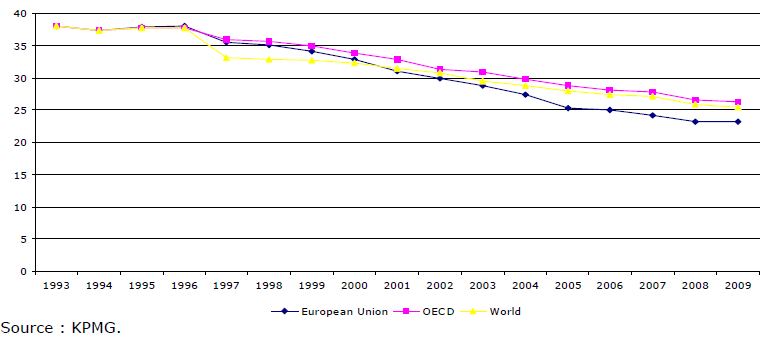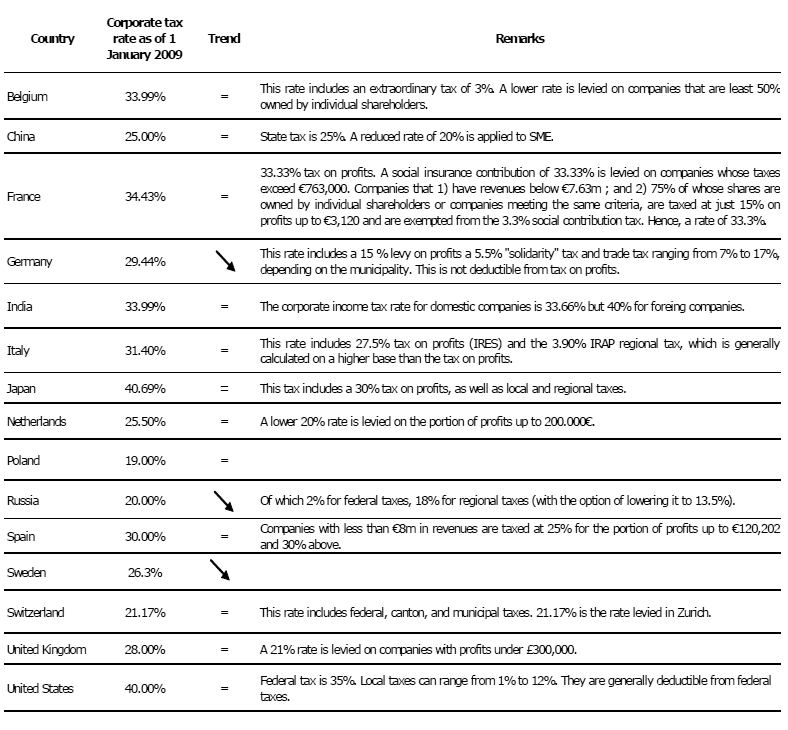Letter number 45 of November 2009
ALL ARTICLES
- TOPIC
- STATISTICS
- RESEARCH
- QUESTIONS & COMMENTS
News : Making money out of one’s own decrepitude
A feature which is curious, to say the least, about the application of the principle of fair value to the balance sheets of banks, is their ability, under IFRS or GAAP, to record profits corresponding to the drop in the market value in certain of their debts, on their income statements.
Accordingly, a bank that has issued a debt of 100 at a yield of 6%, which now is quoted at 80 because of the increase in the rate of return required by bondholders for holding it, given the perceived decline in its solvency, can book a non-taxable profit of 20 on its income statement.
We can imagine that if Lehman Brothers had been able to publish its financial statements for the third quarter of 2008, this profit could have been bigger than the loss on the depreciation of its assets! In short, the bankrupt bank would have been profitable and the dead patient revived!
Without going as far as that, in 2008 Deutsche Bank was able to inflate its earnings by $7.8bn which, if it hadn’t done so, would have been in the red not by €3.9bn but by €9bn.
To illustrate the point, here are the depreciation gains on their debts that were booked by the major international banks in 2008 (in $m):
| Deutsche Bank 7 794 | Barclays 2 084 |
| Morgan Stanley 5 600 | JP Morgan 1 174 |
| Citi 4 558 | Goldman Sachs 1 116 |
| Crédit Suisse 3 151 | BNP Paribas 1 079 |
| UBS 2 517 | Société Générale 499 |
An improvement in their prospects since Spring 2009 has led to a reversal of this phenomenon. Since debts are being revalued at amounts close to their nominal value, banks have to factor this appreciation in on their income statements, and this time as a loss. The result is to reduce current and future earnings generated in the same way as this mechanism previously boosted them.
Most banks adopted this optional treatment, as did a few industrial companies seeking to simplify the way embedded derivatives into debt securities were booked.
Excluding this limited scenario, the explanation is that the banking assets are backed to these debts that finance them and that since the assets are worth less, it is “normal” that the underlying capital losses on these assets that are recorded on the income statement, should be set off by latent capital gains on these debts that finance them.
For our part, as the reader may have guessed from the sarcastically incredulous title of this article, we think that this smacks strongly of hypocrisy. If there has been a decline in the value of the asset, then there is nothing more normal than booking a latent capital loss on the income statement. But to conclude from that that the bank can make money out of the capital loss on its debts, which only reflects a stronger likelihood of bankruptcy, while it still owes this money to its lenders, just doesn’t make sense.
Is this in the best interests of the principle of good information? We have our doubts. Of course, all of the details are explained in the notes to the financial statements, which is where we found the information in the above table. But that provides little reassurance when the average annual report for a bank is generally over 300 pages long!
Incidentally, this application of the principle of faire value to debts appears to us to run contrary to the principle of the continuity of operations. Although the bank is able to book a gain when its debt is devalued, this is because there are more or less pressing doubts over its solvency, and accordingly the continuity of its operations.
In December 2008, the SEC recommended that this option be phased out and in June 2009, the IASB published a discussion paper showing that it is giving the issue a lot of thought.
However, the analysis is very different when the company or the bank, in order to manage its liabilities, decides to buy back debt that is discounted to the par, financing this purchase with the issue of new debt. It will then record a non-recurrent gain corresponding to a real transaction that will boost its equity capital by as much. If the debt acquired and issued is perpetual, the operation is neutral in terms of interest to be paid. The interest rate is, of course, higher on the new debt, but it applies to a reduced nominal, given the discount on the purchase of the debt.
This is not the case if the debt has a given maturity, which explains why companies use this method less, except for debts with very long periods to maturity.
For example, in August 2009, Natixis issued a new perpetual debt for €794m, which was used to buy back €794m worth of debt, the nominal of which was €1187m, enabling it to make a gain of €393m and to strengthen its equity capital by €393m.
Statistics : Corporate income tax rates
After 16 years of uninterrupted reduction, corporate income tax rates have stabilized arroung 25% and sligthly less in the EU (because of lower tax rates of recent members).
You do not need to be a genius to expect that a reversal in this downward trend is likely in the future as states are in dire need of cash!
Research : Hedging and financial decisions
This month we take a look at an article on the use of derivatives by listed French firms. Two researchers at the University of Paris Ouest Nanterre have demonstrated, using an empirical study(1), that the choice to use derivatives or not (to hedge against different risks) is linked to the level of debt (or leverage) of the firm in question. The causality works in two directions: highly leveraged firms use derivatives more often, and the use of derivatives encourages firms to take out more debt.
The assumptions tested by the researchers concerning the rate of leverage are based mainly on two major theories:
• the static capital structure model, which considers that there is an optimal rate of leverage – the advantages of debt (tax and governance arguments) should set off its drawbacks (costs linked to bankruptcy risks and information asymmetry);
• the pecking order theory, which explains that firms use internal financing as much as possible before taking out debt and ultimately increasing the firm’s capital(2).
The decision to use derivatives to hedge against risk is based on two main motivations. On the one hand, the hedge reduces the risk of bankruptcy. On the other hand, the fact that the firm has hedged against risk enables it to avoid the problem of under-investment (firms that fail to implement good projects because they are unable to finance them). When it is expensive to obtain external financing, it is a good idea to reduce the risk of a shortfall in internal financing capacity.
An econometric analysis shows that firms use derivatives more often when:
1. They are highly leveraged. Hedging enables them to limit the risk of bankruptcy and accordingly, bankruptcy related costs.
2. They pay high dividends. This reduces their funds available for investment and accordingly, it is in their best interests to limit the risk of under-investment.
3. They are large firms. There are fixed costs involved in setting up a hedging system using derivatives, which makes this strategy less advantageous to SMEs.
4. They make sales in foreign currency (in this case, they have to hedge against forex losses).
It also shows that the use of derivatives and the choice of the level of leverage are made together – the fact that the risk is hedged encourages higher levels of debt since the risk of bankruptcy is reduced.
In addition to verifying theoretical predictions, the study provides a few interesting descriptive statistics on large French (non-financial) listed firms. Over 60% of such firms hedge against risk using derivatives. Their average leverage (ratio of their long-term debt to the market value of the company) is 11.4%. Their average dividend yield is 1.45%.
(1) K.BEN KHEDIRI et D.FOLUS (2009), Hedging and Financing Decisions, Bankers, Markets and Investors, n°98.
(2) For more on the pecking order, see chapter 34 of the Vernimmen


